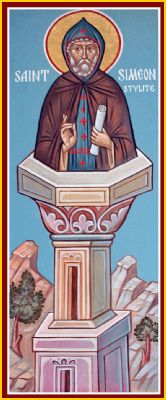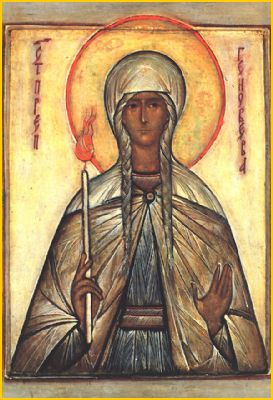|
|||
|---|---|---|---|
| This weekly bulletin insert complements the curriculum published by the Department of Christian Education of the Orthodox Church in America. This and many other Christian Education resources are available at http://dce.oca.org. | |||

Some years ago, the Chilean writer Isabel Allende included, in one of her books, a reference to the pillar-dwelling saints known as stylites. She described them as squandering their lives, never speaking, and sitting always in the same position, unbathed and covered with sores. She added that credulous believers admired this "spectacle" which "supposedly" pleased God. It's hard to know why a person would criticize something she clearly doesn't understand. But she is not alone. There are many who would dismiss the stylites as strange, and wonder why the Church honors them. It is for us to learn more about what they did and what they can teach us. A good person to start with is the first and best-known stylite, Simeon. We know more about this Syrian monk from his disciples than from the man himself, for he left no writings. He never disclosed his reasons or intentions in climbing the pillar. But according to the book "The Lives of the Stylites", translated and edited by Robert Doran, he did a great deal for others. It's unlikely that Simeon set out to attract other people. He only wanted to live a life of prayerful worship in closeness to God. But because he lived that life so well and so authentically, others were drawn to him. It is similar to the way people were drawn to saints like Anthony and Syncletica, who left the crowded world in order to live in quiet prayer. They did not seek followers, but God sent them anyway. People came to Simeon's pillar for counseling and spiritual guidance, which he willingly gave. But he also healed ailments, settled disputes and dispensed justice. For example the book tells us that "when a poor cucumber farmer, the widowed father of children, found his field sabotaged by village bullies he came to Simeon, seeking not only help for his livelihood but justice for what he had suffered." Simeon freed slaves, tore up bonds of indebtedness, and helped orphans and widows. The word of his abilities and integrity spread far: "...they say that he became so well-known in the great city of Rome that small portraits of him were set up on columns at the entrance of every shop..." 
Yet Simeon always retained the essential Christian quality of humility. For example, when he heard of the holy work of Saint Genevieve in Paris he entreated her to pray for him, acknowledging her spiritual eminence. And when his monastic superiors commanded him to leave the pillar, he did so at once, never questioning their judgment or arguing for the importance of continuing his ministry. Simeon and his pillar stand as a reminder that there are many kinds of saints who did many kinds of service to God. Some people in the world may not "get" them, but He embraces them all. |
|||
